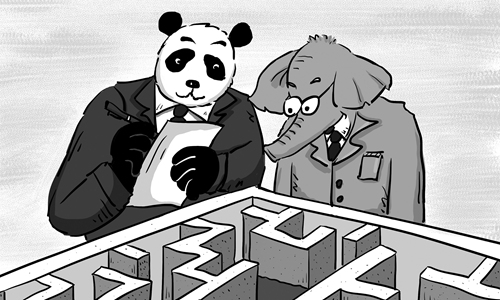Illustration: Chen Xia/GT
By Zhang Yunling
China and India live side by side and have a long history of interactions. The story of the famous Chinese Buddhist monk Xuanzang who lived during the Tang Dynasty (618-907), who traveled from China to India to study Buddhism, has been told from generation to generation.
Both China and India are geographically linked with the Himalaya Mountains, but are apart in their hearts because they lack deep understandings of one the other.
After India won its independence in 1947 and the People’s Republic of China was founded in 1949, the two countries established diplomatic relations in early 1950. They put forward the Five Principles of Peaceful Coexistence, which has far-reaching influence and contributed to the building of a new type of international relations after World War II.
However, after independence, India held an unjustifiable position on the territorial issue. In 1962, after India increased military provocations in border region and attempted to gain territory by force, a war broke out between the two. China launched counterattacks and defeated the Indian troops. Relations soured severely.
Since the end of the Cold War in the late 20th century and the warming of relations in the early 21st century, economic and trade relations between Beijing and New Delhi have witnessed unprecedented levels of development. The two countries have signed agreements to stabilize the border and conducted border talks. Based on their common concerns and interests in the regional and international arena, the positions and policies of the two countries have become more coordinated.
Thus, bilateral relations have entered a new period with more platforms for cooperation such as cooperation mechanisms of BRICS, the Shanghai Cooperation Organization, G20, etc.
However, the development of China-India relations has not always been smooth. The reason is that there are still many problems to be solved. Top of the list is the border dispute. Although the two countries have signed agreements to stabilize their borders and conduct negotiations, no substantial results have been achieved so far. It will be more difficult to reach an effective agreement in the foreseeable future.
If disputes drag on for a long time, it will inevitably cause trouble, like the Doklam standoff in 2017 and the recent incident in the Galwan Valley region. At a time when both countries are growing in overall national strength, it will be harder to reach a border agreement.
The differences in the two countries’ strategies and interests seem to have become a gap blocking the development of bilateral relations. As a rising country, India’s strategic pursuit and established goal is to be a global power. It is eager to become a permanent member of the UN Security Council, but due to the different positioning of its strategic interests, China is cautious in this regard. Beijing insists that the case should be addressed in a comprehensive UN reform plan – it should not be addressed as a stand-alone issue.
Another example is the US-launched Indo-Pacific Strategy with an aim to contain China. Clearly Beijing opposes this. Yet Washington has been drawing New Delhi into its Indo-Pacific efforts. When it comes to the China-proposed Belt and Road Initiative, New Delhi, out of fears that Beijing will take this opportunity to enhance its influence in the Indian Ocean and strengthen its presence in Pakistan and other South Asian countries, strongly opposes the initiative.
All those will cloud cooperation efforts between the two countries.
Many contradictions between the two countries have also become stumbling blocks in bilateral ties. A cooperative Beijing-Islamabad relationship and confrontational Islamabad-New Delhi ties have long become a puzzle that cannot be easily resolved anytime soon.
Beyond this, trade imbalances between China and India may exist for a long time. The differences between the two countries in politics, governance, values and other aspects will also continue to strain ties.
How should China and India get along? In my opinion, there are two basic needs: First, China and India are not and should not be strategic rivals. Second, there is no reason for China and India to go to war again. Disputes can be eased or cooled down through consultation. If those can become the consensus of China and India, and serve as the bottom line of strategic thinking of both sides, a ground-breaking progress could be made.
From a pragmatic perspective, even if it is difficult for the two countries to become good friends, they can also become partners of cooperation. China and India account for nearly 40 percent of the world’s population. It is estimated that by the middle of this century, both countries will be among the world’s top three superpowers in terms of overall strength. It will only be a beautiful world with the dragon and the elephant dancing together rather than fighting.


